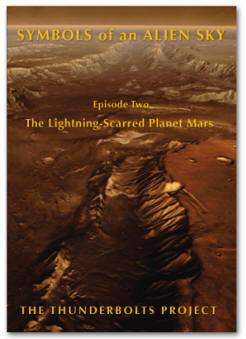|

Active galaxies (red crosses) in new
study that disproves the proven
theory
of galaxy mergers. Credit: CFHT/IAP/Terapix/CNRS/ESO
Astronomical Fashion Flips
Jul 15, 2011
Mergers are out. Vanity is in:
active galaxies are self-absorbed.
For many years, the only
acceptable explanation of high
galactic x-ray output accompanied by
high redshift was mergers of
galaxies. The universe became a
bumper-car arena where every
presumed high-energy event was proof
of a collision.
Proof has just collided with
disproof in a
new study that examined
600 high-redshift active galaxies. A
team of astronomers identified the
active galaxies from observations
with the XMM-Newton x-ray telescope.
Next, they obtained spectra of
the galaxies with ESO’s Very Large
Telescope. They took liberties with
the language and claimed to have
“measure[d] the distances to the
galaxies.” What they actually did
was to measure each galaxy’s
redshift and to calculate a number
from it. They called this number
“distance” in conformity with the
consensus presumption that redshift
is “how much the light has been
stretched by the expansion of the
Universe.”
With these numbers, they
constructed a three-dimensional
map—which was actually a
four-dimensional map, since under
the expanding-universe assumptions
distance is also an indicator of
time. Using the map as a guide (one
recalls the saying about the blind
leading the blind), they finally
“studied” the changing distribution
of galaxies that was assumed to have
occurred during the early stages of
the hypothetical Big Bang.
“The team found that most active
nuclei reside in galaxies with
masses about 20 times larger than
the value predicted by merger
theory.” Viola Allevato, the lead
author of the paper reporting the
results, said, “They indicate that
black holes are usually fed by
processes within the galaxy
itself..., as opposed to galaxy
collisions.”
Oops.
The consensus reasoning begins
with the proposition that redshift
indicates distance, despite the
by-now-tiresome quantities of
evidence that falsify, disprove,
contradict, question, and do
other unpleasant things
to it. A faint light that is far
away can only mean that the light is
actually very strong, as long as you
don’t entertain any other
possibility. A strong light requires
a large quantity of mass (whatever
that is) to produce it, assuming, of
course, that you allow no other
assumptions to be considered.
If redshift does not indicate
distance...(the chain of logic is
left as an
exercise for the reader).
In the Electric Universe, a large
part of the redshift of a body
(quasar, galaxy, even a
star) is intrinsic and
probably due to the charge on the
body. It is an indicator of the age
since the body was formed or
ejected, as distinguished from “age
since the big bang.” High-redshift
objects are fragments of violent,
far-from-equilibrium plasma
discharges from relatively nearby
galaxies: they are small, faint, and
nearby (compared to the “ultra”
designations of the consensus
theories).
Since they are electrical
discharges, mass is of little
concern and black-hole theory is
unnecessary. They don’t “merge,” but
neither do they “feed.” They are
loads in an intergalactic circuit
that is subject to instabilities and
can discharge energy from the
circuit—more than is available
locally.
If a false proposition has no
real-world adverse consequences—such
as a building collapsing if a beam
is wrongly sized—there’s no urgency
in discarding it. If one is being
rewarded—with money, reputation, or
power—for advocating it, there is a
strong incentive to deny its
falsity. Whether the universe is
expanding or turning into chicken
soup has no noticeable effect on the
price of gasoline.
For the layman, astronomy press
releases have the same value as the
latest gossip about Lady Gaga (or
perhaps a bit less). With no anchor
to consequential effects,
fashion becomes the
ultimate criterion of acceptability.
Mel Acheson
 New
DVD New
DVD
The Lightning-Scarred
Planet Mars
A video documentary that could
change everything you thought you
knew about ancient times and
symbols. In this second episode of
Symbols of an Alien Sky, David
Talbott takes the viewer on an
odyssey across the surface of Mars.
Exploring feature after feature of
the planet, he finds that only
electric arcs could produce the
observed patterns. The high
resolution images reveal massive
channels and gouges, great mounds,
and crater chains, none finding an
explanation in traditional geology,
but all matching the scars from
electric discharge experiments in
the laboratory. (Approximately 85
minutes)
Video Selections
Order Link
|





 New
DVD
New
DVD

